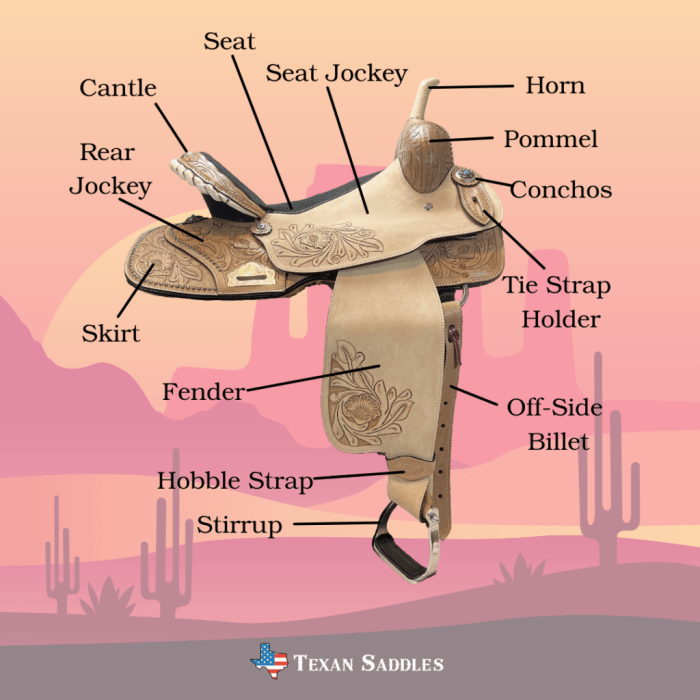Unveiling the intricate world of equestrian equipment, we delve into the parts of a saddle diagram, providing a comprehensive guide that empowers riders with essential knowledge. This exploration promises to illuminate the significance of each component, enhancing both horse and rider comfort and performance.
From the saddle’s foundation to its intricate accessories, we unravel the secrets of saddle design and fit, ensuring an immersive understanding that transcends mere functionality and elevates the art of horsemanship.
Components of a Saddle: Parts Of A Saddle Diagram
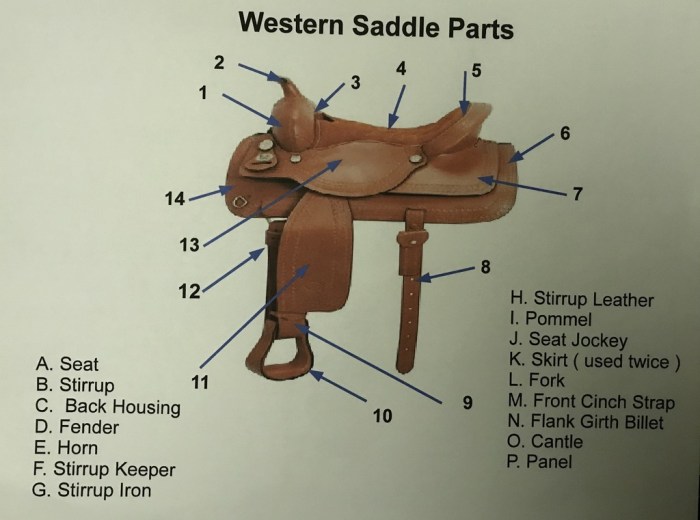
A saddle is an essential piece of equipment for horseback riding, providing both comfort and support for the rider. It consists of several key components that work together to ensure a secure and comfortable ride.
The primary parts of a saddle include the seat, pommel, cantle, stirrups, fenders, and girth. Each component plays a specific role in the saddle’s functionality and design.
Materials Used in Saddle Construction
Saddles are typically constructed from a combination of materials, including leather, wood, and metal. Leather is a common choice for the seat, fenders, and girth due to its durability, flexibility, and comfort. Wood is often used for the saddle tree, which provides the structural support for the saddle.
Metal components, such as stirrups and buckles, add strength and durability to the saddle.
Types of Saddles
There are various types of saddles designed for specific riding disciplines. English saddles are typically used for jumping and dressage, featuring a flat seat and forward-cut flaps that allow for a closer connection between the rider and horse. Western saddles, on the other hand, are designed for tasks such as roping and herding cattle, with a deep seat and a horn at the front for securing ropes.
Endurance saddles are specifically designed for long-distance riding, providing maximum comfort and support for both the rider and horse.
Saddle Design and Fit
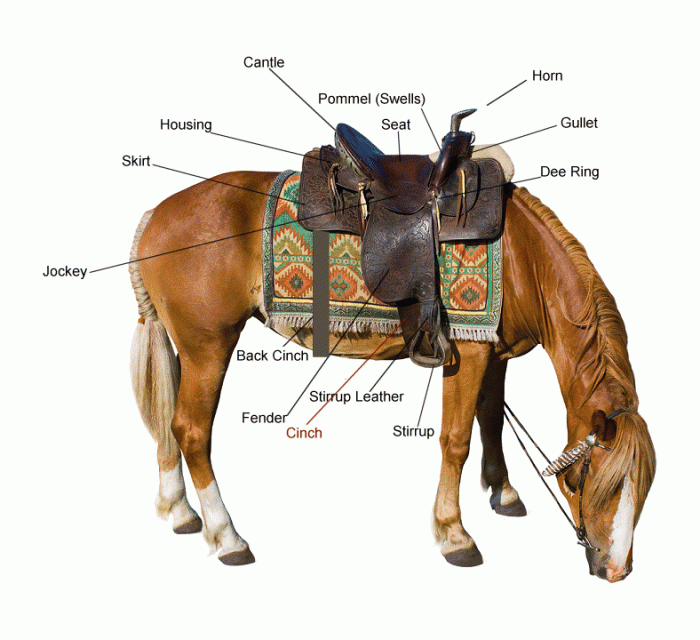
A well-fitting saddle is crucial for both horse and rider comfort and performance. An ill-fitting saddle can cause discomfort, pain, and even injury to the horse, while also hindering the rider’s ability to ride effectively.
The process of saddle fitting involves measuring the horse’s back and the rider’s body to determine the correct saddle size and shape. Saddle trees, which provide the framework for the saddle, come in different shapes and sizes and play a significant role in saddle fit.
Measuring the Horse’s Back
To measure the horse’s back, the saddle fitter will use a flexible measuring tape to determine the distance from the withers (the highest point of the shoulder blades) to the last rib.
Measuring the Rider’s Body
The rider’s body measurements, including inseam, thigh length, and hip width, are also taken to ensure that the saddle fits the rider comfortably.
Types of Saddle Trees
Saddle trees are typically made of wood or synthetic materials and come in different shapes and sizes to accommodate different horse and rider combinations. The most common types of saddle trees include:
- Flat trees:These trees have a relatively flat profile and are designed for horses with wide, flat backs.
- Semi-quarter trees:These trees have a slightly curved profile and are designed for horses with medium-width backs.
- Quarter trees:These trees have a more pronounced curve and are designed for horses with narrow, high-withered backs.
- Full-quarter trees:These trees have the most pronounced curve and are designed for horses with very narrow, high-withered backs.
Saddle Accessories
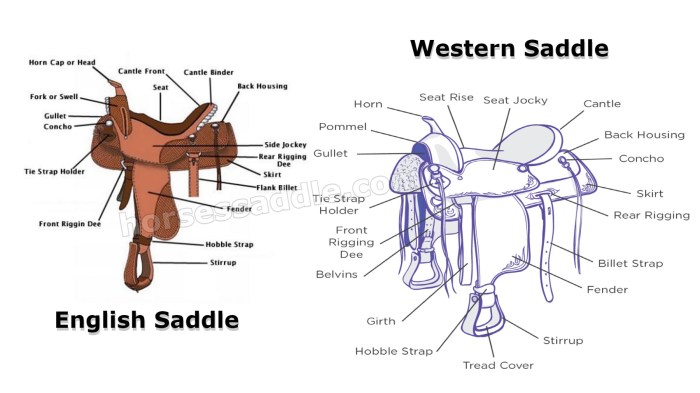
Saddle accessories enhance the functionality, comfort, and safety of your riding experience. They can protect your saddle, provide additional support and cushioning, and make it easier to carry essential items.
Here are some of the most common saddle accessories:
Saddle Pads
Saddle pads are placed between the saddle and the horse’s back to provide cushioning and protection. They come in various materials, including wool, foam, and gel, each offering different levels of comfort and shock absorption.
- Wool pads:Natural and breathable, wool pads wick away moisture and conform to the horse’s back for a comfortable fit.
- Foam pads:Lightweight and affordable, foam pads provide cushioning but may not offer as much breathability as wool.
- Gel pads:High-tech and shock-absorbent, gel pads provide maximum protection for the horse’s back and can help reduce pressure points.
Saddlebags
Saddlebags are used to carry essential items while riding, such as snacks, water bottles, or first aid kits. They attach to the saddle’s side or back and come in various sizes and materials.
- Leather saddlebags:Durable and classic, leather saddlebags add a touch of style to your riding gear.
- Canvas saddlebags:Lightweight and affordable, canvas saddlebags are a practical choice for casual riders.
- Waterproof saddlebags:Essential for wet weather, waterproof saddlebags protect your belongings from rain and mud.
Stirrup Leathers
Stirrup leathers connect the stirrups to the saddle and determine the rider’s leg length. They come in different lengths and materials, including leather, nylon, and synthetic fibers.
The gullet, fenders, and cantle are just a few of the parts that make up a saddle. Like the watch in the watch by Elie Wiesel , each part plays a crucial role in the overall function of the saddle, ensuring a comfortable and secure ride.
- Leather stirrup leathers:Durable and stylish, leather stirrup leathers are a classic choice.
- Nylon stirrup leathers:Lightweight and affordable, nylon stirrup leathers are easy to clean and maintain.
- Synthetic fiber stirrup leathers:High-tech and durable, synthetic fiber stirrup leathers are less prone to stretching or breaking.
Saddle Care and Maintenance
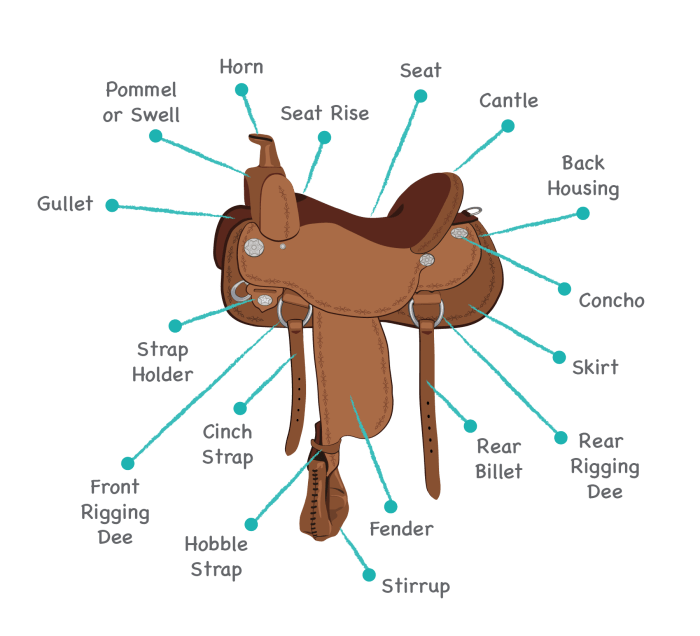
Regular saddle care is essential to maintain its condition and extend its lifespan. A well-cared-for saddle will provide a comfortable and secure ride for years to come. Here’s a step-by-step guide to cleaning and conditioning a saddle:
Cleaning
- Remove loose dirt and debris with a soft brush or damp cloth.
- Use a mild saddle soap and warm water to clean the saddle. Avoid using harsh chemicals or detergents, as they can damage the leather.
- Rinse the saddle thoroughly with clean water and allow it to dry completely before conditioning.
Conditioning
- Apply a saddle conditioner to the leather using a clean cloth or sponge.
- Work the conditioner into the leather in a circular motion.
- Allow the conditioner to soak in for several hours or overnight before wiping off any excess.
Signs of Saddle Wear and Tear
- Cracks or tears in the leather
- Dry or brittle leather
- Loose or broken stitching
- Rusty or damaged hardware
Addressing Saddle Wear and Tear, Parts of a saddle diagram
- Small cracks or tears can be repaired with a leather repair kit.
- Dry or brittle leather can be treated with a leather conditioner.
- Loose or broken stitching should be repaired by a professional saddler.
- Rusty or damaged hardware can be replaced.
Question Bank
What are the key components of a saddle?
The primary parts of a saddle include the seat, pommel, cantle, stirrups, fenders, and girth.
How does saddle fit impact horse and rider comfort?
Proper saddle fit is crucial for both horse and rider comfort and performance, as an ill-fitting saddle can cause discomfort, pain, and performance issues.
What are the different types of saddle accessories?
Saddle accessories include saddle pads, saddlebags, stirrup leathers, saddle covers, and saddle soap.
